From the Trenches
A Mix of Faiths
By JASON URBANUS
Monday, February 13, 2017
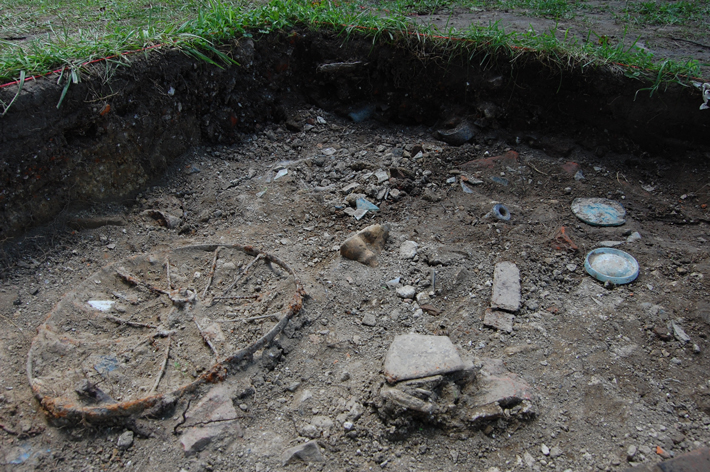
A unique assemblage of circular artifacts embodying both traditional African spiritual symbols and biblical iconography was unearthed by archaeologists Elizabeth Pruitt and Benjamin A. Skolnik on the grounds of a former plantation where abolitionist Frederick Douglass once lived. Excavations beneath a nineteenth-century tenant farmer’s home at Wye House produced objects depicting an African cosmogram—an X inside a circle—and another that is believed to be a representation of Ezekiel’s wheel. Since both symbols signify life and the universe, enslaved Africans may have drawn connections between the two when they were first introduced to Christianity. “West African religion, which features the cosmogram, is transformed through song, visions, and preaching in early black churches,” says University of Maryland archaeologist and project director Mark Leone. “The hypothesis we operate on is that the cosmogram, the circle, and the singing of songs such as Ezekiel Saw the Wheel are all movements to and direct experiences of the divine.”
The excavations at Wye House have been ongoing, and in 2006 deputy editor Samir S. Patel visited the site and wrote about the research, how Frederick Douglass was affected by his time there as a child, and how local descendant communities have learned from the work. To read his piece, go to “A Community's Roots.”
Royal Gams
By DANIEL WEISS
Monday, February 13, 2017
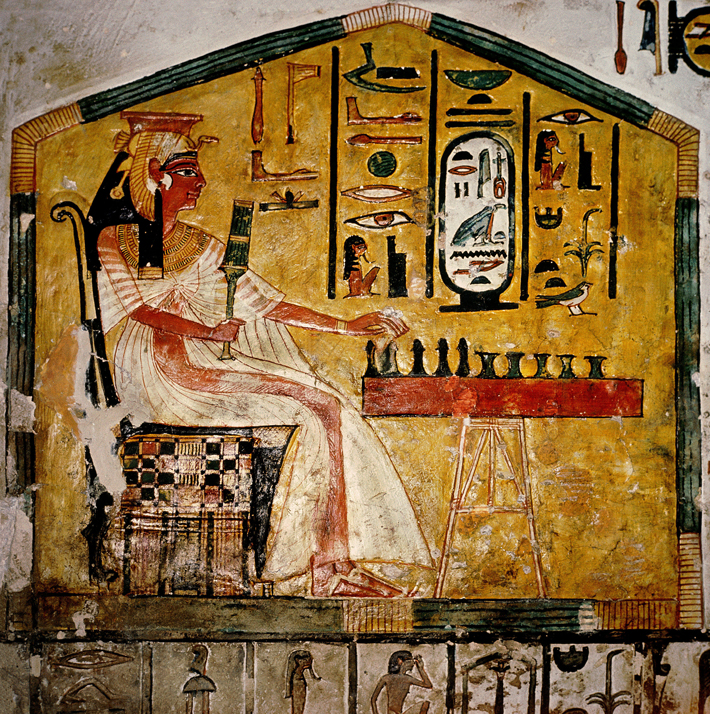 The tomb of Egypt’s Queen Nefertari, the favorite wife of Ramesses II (r. 1279–1213 B.C.), in the Valley of the Queens, was ransacked in antiquity and her mummy torn apart by robbers. Now, a multidisciplinary team has analyzed a pair of legs found in the tomb to determine whether they were hers. Measurements and X-rays of the legs, displayed at the Egyptian Museum in Turin, Italy, have established that they belonged to a woman who was at least 40 years old and stood around five feet six inches tall. In addition, materials used to embalm the legs are consistent with mummification traditions of Nefertari’s time. While radiocarbon dating returned results predating her presumed lifespan by 200 years, Michael Habicht of the University of Zurich notes that this could be due to a broader challenge facing scholars attempting to radiocarbon date samples from Egypt’s New Kingdom. Although the identification is far from definitive, he says, the legs most likely did belong to Nefertari.
The tomb of Egypt’s Queen Nefertari, the favorite wife of Ramesses II (r. 1279–1213 B.C.), in the Valley of the Queens, was ransacked in antiquity and her mummy torn apart by robbers. Now, a multidisciplinary team has analyzed a pair of legs found in the tomb to determine whether they were hers. Measurements and X-rays of the legs, displayed at the Egyptian Museum in Turin, Italy, have established that they belonged to a woman who was at least 40 years old and stood around five feet six inches tall. In addition, materials used to embalm the legs are consistent with mummification traditions of Nefertari’s time. While radiocarbon dating returned results predating her presumed lifespan by 200 years, Michael Habicht of the University of Zurich notes that this could be due to a broader challenge facing scholars attempting to radiocarbon date samples from Egypt’s New Kingdom. Although the identification is far from definitive, he says, the legs most likely did belong to Nefertari.
Zinc Zone
By JARRETT A. LOBELL
Monday, February 13, 2017
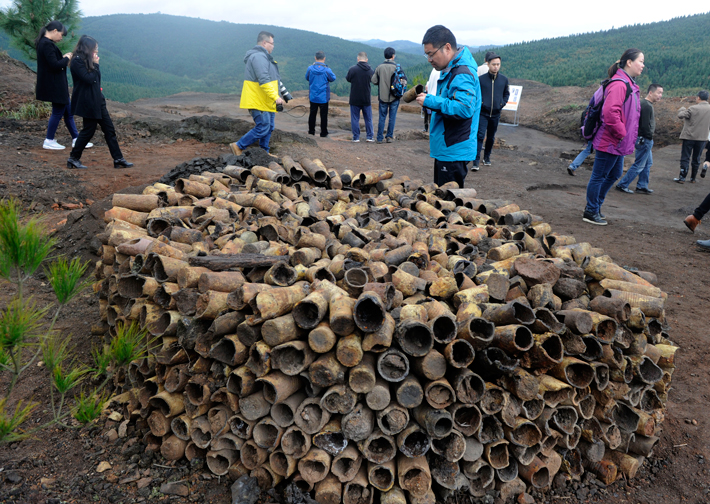 In central China’s Hunan Province, archaeologists have uncovered evidence of a zinc production site dating to the late Ming Dynasty (1368–1644). The finds include large smelting furnaces as well as zinc slag, the by-product of the conversion of zinc ores to pure zinc. Along with India, China was one of the major production centers for zinc between the twelfth and eighteenth centuries, after which the material began to be produced on a larger scale in Europe.
In central China’s Hunan Province, archaeologists have uncovered evidence of a zinc production site dating to the late Ming Dynasty (1368–1644). The finds include large smelting furnaces as well as zinc slag, the by-product of the conversion of zinc ores to pure zinc. Along with India, China was one of the major production centers for zinc between the twelfth and eighteenth centuries, after which the material began to be produced on a larger scale in Europe.
Behind the Curtain
By MARLEY BROWN
Monday, February 13, 2017
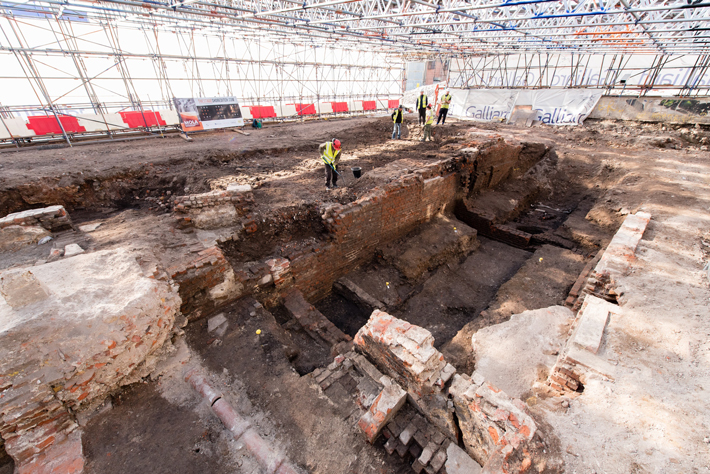
One of London’s earliest Elizabethan theaters has surprised archaeologists and Shakespearean scholars alike with its rectangular-shaped stage, a unique departure from the polygonal style of more famous playhouses such as the Globe. Researchers from Museum of London Archaeology (MOLA) made the discovery while excavating the Curtain Theatre in Shoreditch, East London, on a site set to house a commercial and residential complex, where the theater’s remains will be preserved in situ.
The Curtain, which opened in 1577 and served as the main venue for Shakespeare’s plays from 1597 to 1599, was only the second theater in London built specifically to host performances. Previously, plays had been performed in public houses, inn yards, patrons’ private residences, and even open spaces. MOLA’s excavation shows that the Curtain featured a hidden passageway under the stage where actors could move undetected. Its distinctive architecture has prompted speculation about the Bard’s work from that period. “So many big research questions emerge,” says Heather Knight, MOLA senior archaeologist. “Are people like Shakespeare and his contemporaries writing plays specifically for this kind of stage? Does it lend itself to battle scenes, does it lend itself to having more people on stage, does it affect how they interact?”
Enthusiasm for the Curtain Theatre discovery is sure to cross disciplines too. “Many think of Shakespeare’s era as ‘wrapped up,’ with few new insights likely to change the way we think about Shakespeare the playwright or his plays,” adds author and Shakespeare authority Leslie Dunton-Downer. “The recent archaeological work in Shoreditch demonstrates that plenty remains to be discovered about the Bard and how his plays were performed and attended.”
In addition to the secret tunnel feature, the excavation also produced dramaturgical artifacts such as glass beads and pins—perhaps from costumes—as well as fragments of drinking vessels and clay pipes likely belonging to revelers in the audience and backstage.
A Surprise City in Thessaly
By JASON URBANUS
Monday, February 13, 2017
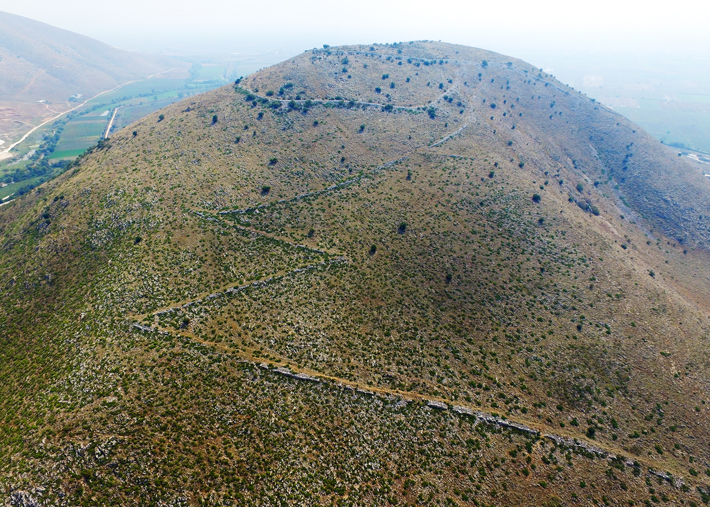
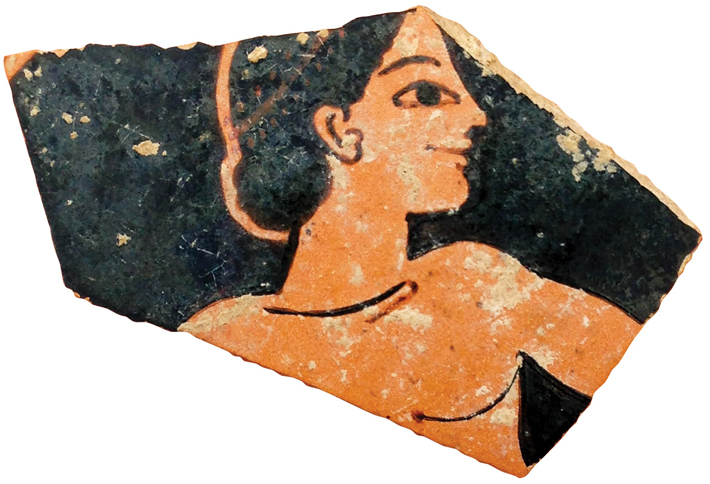 Archaeologists have identified the unexpected remains of a large, 2,500-year-old Greek settlement in western Thessaly. The existence of the hilltop site, near the modern village of Vlochos, had been known for more than two centuries, but had never been systematically investigated. Although large defensive walls were visible in some places, experts had long believed that the ancient settlement was fairly insignificant. This opinion changed when a Greek-Swedish team recently discovered the existence of a complex urban center. The team was stunned when the results of their geophysical survey indicated that the ancient site is spread across 100 acres and boasts an organized, orthogonal, or gridded street plan. Scholars believe that the town flourished in the fourth and third centuries B.C. before being abandoned. “The work at Vlochos gives a rare insight into the development and outline of a typical Thessalian city,” says University of Gothenburg archaeologist Robin Rönnlund. “It shows that even midsize settlements of this region were quite sophisticated in their spatial outline.”
Archaeologists have identified the unexpected remains of a large, 2,500-year-old Greek settlement in western Thessaly. The existence of the hilltop site, near the modern village of Vlochos, had been known for more than two centuries, but had never been systematically investigated. Although large defensive walls were visible in some places, experts had long believed that the ancient settlement was fairly insignificant. This opinion changed when a Greek-Swedish team recently discovered the existence of a complex urban center. The team was stunned when the results of their geophysical survey indicated that the ancient site is spread across 100 acres and boasts an organized, orthogonal, or gridded street plan. Scholars believe that the town flourished in the fourth and third centuries B.C. before being abandoned. “The work at Vlochos gives a rare insight into the development and outline of a typical Thessalian city,” says University of Gothenburg archaeologist Robin Rönnlund. “It shows that even midsize settlements of this region were quite sophisticated in their spatial outline.”
Advertisement
Advertisement
IN THIS ISSUE
Features
The First American Revolution
Kings of Cooperation
The Road Almost Taken
Letter from Philadelphia
From the Trenches
Digging up Digital Music
Off the Grid
Revisiting Montezuma Castle
Secret Spaces
Something New for Sutton Hoo
A Surprise City in Thessaly
Zinc Zone
Behind the Curtain
Royal Gams
A Mix of Faiths
Neolithic FaceTime
Bathing, Ancient Roman Style
The Church that Transformed Norway
Siberian William Tell
A Traditional Neanderthal Home
Artifact
Self-expression in the Bronze Age
Advertisement

Recent Issues
-
 May/June 2024
May/June 2024
-
 March/April 2024
March/April 2024
-
 January/February 2024
January/February 2024
-
 November/December 2023
November/December 2023
-
 September/October 2023
September/October 2023
-
 July/August 2023
July/August 2023
-
 May/June 2023
May/June 2023
-
 March/April 2023
March/April 2023
-
 January/February 2023
January/February 2023
-
 November/December 2022
November/December 2022
-
 September/October 2022
September/October 2022
-
 July/August 2022
July/August 2022
-
 May/June 2022
May/June 2022
-
 March/April 2022
March/April 2022
-
 January/February 2022
January/February 2022
-
 November/December 2021
November/December 2021
-
 September/October 2021
September/October 2021
-
 July/August 2021
July/August 2021
-
 May/June 2021
May/June 2021
-
 March/April 2021
March/April 2021
-
 January/February 2021
January/February 2021
-
 November/December 2020
November/December 2020
-
 September/October 2020
September/October 2020
-
 July/August 2020
July/August 2020
-
 May/June 2020
May/June 2020
-
 March/April 2020
March/April 2020
-
 January/February 2020
January/February 2020
-
 November/December 2019
November/December 2019
-
 September/October 2019
September/October 2019
-
 July/August 2019
July/August 2019
-
 May/June 2019
May/June 2019
-
 March/April 2019
March/April 2019
-
 January/February 2019
January/February 2019
-
 November/December 2018
November/December 2018
-
 September/October 2018
September/October 2018
-
 July/August 2018
July/August 2018
-
 May/June 2018
May/June 2018
-
 March/April 2018
March/April 2018
-
 January/February 2018
January/February 2018
-
 November/December 2017
November/December 2017
-
 September/October 2017
September/October 2017
-
 July/August 2017
July/August 2017
-
 May/June 2017
May/June 2017
-
 March/April 2017
March/April 2017
-
 January/February 2017
January/February 2017
-
 November/December 2016
November/December 2016
-
 September/October 2016
September/October 2016
-
 July/August 2016
July/August 2016
-
 May/June 2016
May/June 2016
-
 March/April 2016
March/April 2016
-
 January/February 2016
January/February 2016
-
 November/December 2015
November/December 2015
-
 September/October 2015
September/October 2015
-
 July/August 2015
July/August 2015
-
 May/June 2015
May/June 2015
-
 March/April 2015
March/April 2015
-
 January/February 2015
January/February 2015
-
 November/December 2014
November/December 2014
-
 September/October 2014
September/October 2014
-
 July/August 2014
July/August 2014
-
 May/June 2014
May/June 2014
-
 March/April 2014
March/April 2014
-
 January/February 2014
January/February 2014
-
 November/December 2013
November/December 2013
-
 September/October 2013
September/October 2013
-
 July/August 2013
July/August 2013
-
 May/June 2013
May/June 2013
-
 March/April 2013
March/April 2013
-
 January/February 2013
January/February 2013
-
 November/December 2012
November/December 2012
-
 September/October 2012
September/October 2012
-
 July/August 2012
July/August 2012
-
 May/June 2012
May/June 2012
-
 March/April 2012
March/April 2012
-
 January/February 2012
January/February 2012
-
 November/December 2011
November/December 2011
-
 September/October 2011
September/October 2011
-
 July/August 2011
July/August 2011
-
 May/June 2011
May/June 2011
-
 March/April 2011
March/April 2011
-
 January/February 2011
January/February 2011
Advertisement






